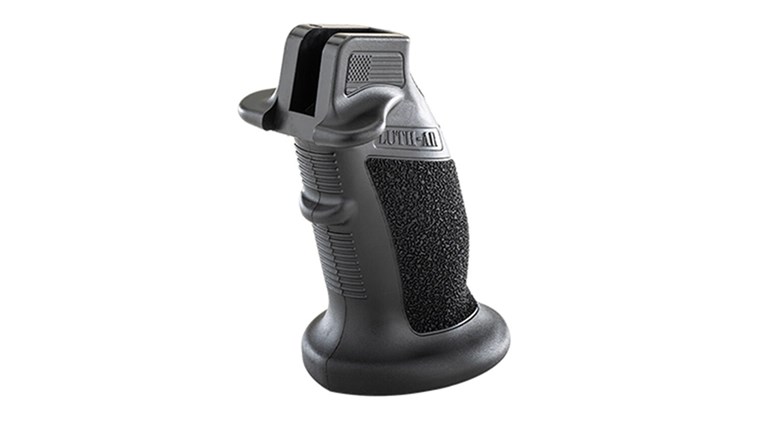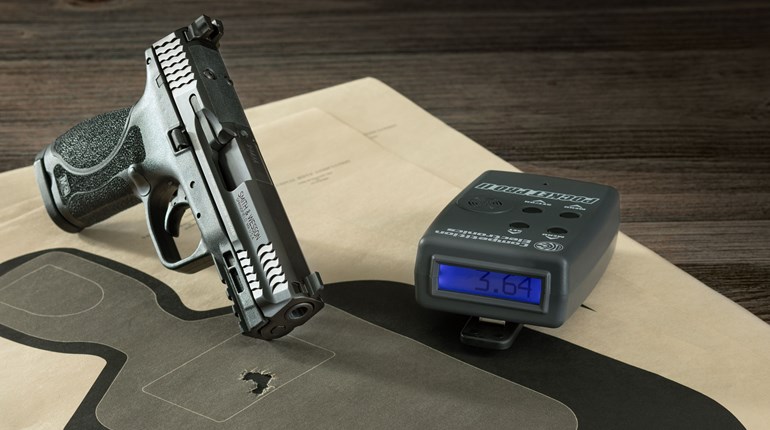
One of the most difficult things about learning to shoot a handgun well is the general inability to see yourself, so to speak, “in action.” Certainly the advent of smartphones or GoPro-like cameras helps to some extent. Just take a look at YouTube—or similar sites like these—and you’ll find plenty of shooting content.
That’s the good news. The bad is generally self-evident: Between sketchy production values and weak content leavened with dashes of comparatively gross safety violations, the remaining percentage that is actually useful is actually pretty small, too. It doesn’t take long to figure out that just having a good camera does not a Milius, Huston or Wilder make.
Furthermore—and most importantly when it comes to getting better—watching others do something you’re trying to emulate is at most half the battle. No matter how excellent the technique and its capture, there’s no substitute for seeing yourself do, or not do, the thing in question. Mix in one or more of those safety issues, and improvement gets more difficult still.
So it is with the “flail,” or “flutter” of the weak hand fingers. Because it happens on the front of the handgun, cautious geometry is necessary to see (much less capture) any occurrence. It has the additional disadvantage of being rapid, variously subtle and often irregular.
What we’re looking for is evidence that the grip from the weak hand side is essentially being released and re-established between shots.“Grrrrr,” sigh, or both?
In the end, you’ll probably need a training partner who knows what to look for to diagnose this problem. Obviously, they can’t stand downrange as you shoot, but just short of 90 degrees is safely possible. While it’s a weak hand problem (the left side, for most shooters), it’s actually easier to see from the right side because the unhelpful motion of the fingertips is most pronounced there. Just watch out for ejecting brass from a semi-auto.
Longer strings of fire are the best way to “excite” the flail. This means five or six shots at a consistent, rapid pace (sub-second consecutive shots are usually sufficient), but such speed can also make the telltale finger movements harder to spot. An auditory clue may help—listen for cadence changes, as these often signal the unavoidable shot-to-shot delay a flail introduces.
What we’re looking for is evidence that the grip from the weak hand side is essentially being released and re-established between shots. While it’s rare for the weak hand to come entirely off the gun, a subtler flutter of the fingers—starting with the pinky, and rippling rapidly up and then down again—is very nearly as troublesome. Mild versions reset only the pinky, ring and middle fingers and perhaps not after every shot; severe versions go all the way to the thumb and back before prep for a subsequent shot is complete, and consequently may make even true pairs of shots impossible.
This is a problem for several reasons. Foremost, it’s illustrative of a mechanically weak grasp of the pistol. This can have several antecedents, but the most common and glaring is “burying” of the strong hand thumb under the palm of the weak hand. Particularly for those who initially trained with a revolver, the practice is not uncommon, nor even wrong in a literal sense. (See the first inset photo here.) But to pretend it is not a self-inflicted disadvantage of major proportions is insupportable; hence, it is something to be winnowed out of your technique.
Once a flail gets in your head, you’re likely to do it on every handgun.The principal damage of burying the thumb stems from the diameter increase that the weak hand must try to overcome. In the most elemental terms, think of it this way: The closer you can press the tips of your fingers to your palm short of touching, the stronger your grip on any object will generally be. Moving the master hand thumb up on top of the weak hand thumb reduces the diameter by decreasing the span of the weak side palm and fingers, with a corresponding increase in grip strength. You’ll often see the correct method referred to as “thumb over thumb.”
Adopting this won’t cure a flail per se, but it improves both actual and perceived gripping power. At the least, it will reduce the urge to reset with a flail.
A second aid in eliminating the weak-hand finger movement is to make sure those fingers have a repeatable “target” position when the grip is initially established. Not just any old wrap will do. Here, modern technique is all but unanimous that the natural grooves formed by the strong hand fingers is where the weak side fingers should wrap. Overlay order from the bottom up should be weak side pinky, strong side pinky, weak side ring, strong side ring, weak side middle, strong side middle, and weak side index (see our main image above). Both these last two should be as solidly up against the bottom side of the trigger guard as ergonomically possible. Note that you don’t need to be at the range to confirm or practice this in your dry training.
A third self-sabotage may also strike a familiar chord: pushing the firearm out too far. This has been the subject of our pillory from many perspectives, but the crucial deficiency is the same in a net sense: Pushing the handgun out too far feels rigid/steady, but it depends mostly on smallish muscle groups that tire too quickly for consistent gun retention strength (and why the flutter may only appear every second or third shot). This fatigue is not only a quite literal invitation to such a grip reset, but also even less effective. It consumes, rather than preserves, finger strength.
Pulling the pistol in toward you even slightly—both elbows should have some bend—brings much larger groups of muscles into play at a smaller percentage of their total power, with correspondingly superior endurance and power. If nothing else, it reduces the actual need to flail the fingers, though habit may keep the motion in play.
Like many things in shooting, you’ll only dump the flail with disciplined practice, though we do have several hints. Perhaps the best is to not use too much gun: Once a flail gets in your head, you’re likely to do it on every handgun. So get it out of your head on the softest-recoiling firearm you have. Nothing wrong with rimfire for this purpose, and the inexpensive reps of .22 are heaven-sent in this respect.
Scrubbed of this pseudo-appeal and the technical flaw it betrays, the flail is essentially a tick.Next, and briefly, we don’t care about anything but dumping the flail. Your accuracy may suffer. Until you get to the point where you’re establishing a good grip and maintaining it without the flail/flutter re-grip through sting counts up to 10 rounds, just be sure you’re still hitting a safe backstop. (Subtext here: Expect to burn some rounds.)
Then, look at your pistol. Grips on many firearms are aesthetically pleasing, but ergonomically flawed at the tactile level. Especially if you’re dealing with polished wood, something else may be required. “Stippling” is a common (but permanent and perhaps competitively forbidden) fix on polymer frames, but grip tape can serve as well (not competitively forbidden, and removable). Grip enhancers are commonly used in the competitive world, and have the advantage of working on virtually every grip style, and simply washing off at the end of a session. We acknowledge these won’t be available for every shooting occasion—especially not in sudden-onset defensive/protective circumstances—but they’ll help establish the proper reflexive grasp that should be your goal. We can’t recommend gloves (as explained in detail here).
Last, think seriously about where this habit likely sprung from. We hate to say it, but the germ of this is a movie/TV thing. Granted, grip issues are real, but the flutter/flail as a cure is straight out of dozens of repetitions in the media from many eras. Start looking, and you’ll see it all the time, especially when the protagonist or antagonist is lining up a high-precision shot. It intones, so to speak, deliberation and subsequent accuracy, but has no corollary in real-world shooting that we can find.
Scrubbed of this pseudo-appeal and the technical flaw it betrays, the flail is essentially a tick. Dumping it, however, is not merely aesthetic. It will also enable you to regain wasted energy and motion that stand between you and expeditious, high-quality follow-up shots. No matter how you’re exercising your freedom, that’s worth cultivating.
Frank Winn has been studying arms and their relationship to tyranny, meaningful liberty and personal security all his adult life. He has been a firearms safety/shooting instructor for more than 20 years, and earned state, regional and national titles in several competitive disciplines.


































